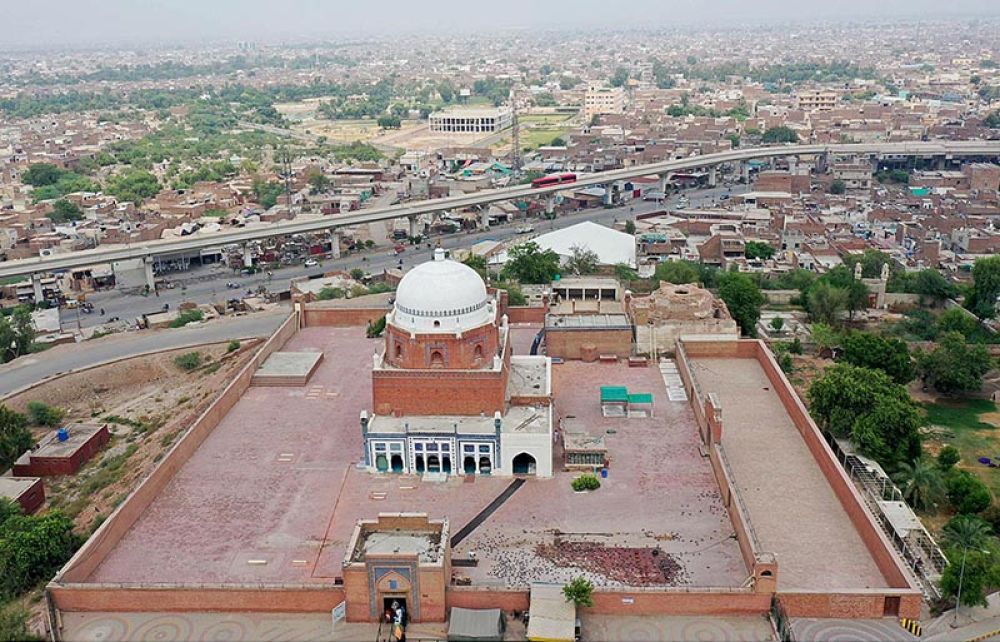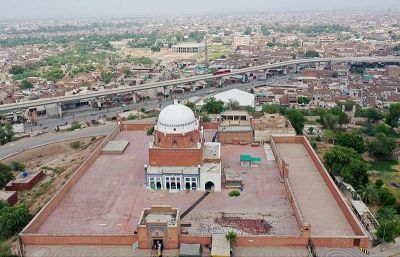

The Shrine of Bahauddin Zakariya, located in the heart of Multan, Pakistan, is a prominent Sufi mausoleum and a significant religious site attracting pilgrims and history enthusiasts alike. A guided tour of this 13th-century marvel takes you on a journey through time, offering insights into the life and teachings of the revered Sufi saint Bahauddin Zakariya. As you walk through the intricate Islamic architecture, you will notice the distinct Multani style, characterized by the impressive brickwork and blue tiles that adorn the shrine. The guide will provide an in-depth narrative of the shrine's construction, its historical significance, and its role in the spread of Islam in the region. Throughout the tour, you will have the opportunity to learn about the rituals and traditions associated with the shrine, witness the devotees paying respects, and see the vibrant culture of the local community.
Every year, the mausoleum of Bahauddin Zakariya becomes the epicenter of a major religious festival known as the Urs, which commemorates the death anniversary of the Sufi saint. Visitors from all over the country and beyond come to partake in this event. Attending the Urs festival gives a unique glimpse into the enduring spiritual and cultural practices prevalent in the region. During the festival, you can immerse yourself in the vivid atmosphere filled with devotional music, Qawwali performances, and spiritual dances like Dhammal. Pilgrims pay homage to the saint, and the air is filled with the fragrance of rose petals and incense. The chaotic, yet fascinating bazaar that springs up around the shrine during the festival offers numerous stalls selling traditional foods, handicrafts, and religious artifacts. The Urs provides a remarkable experience that is as much a cultural feast as it is a religious observance.
The Shrine of Bahauddin Zakariya is not just an architectural masterpiece but also a cultural hub for Sufi music lovers. An activity that has become synonymous with Sufi shrines is the soul-stirring live performances of Qawwali, which is traditional Islamic devotional music. These sessions are typically led by groups of talented musicians who perform in the courtyard of the shrine. As you sit within the walls of this ancient monument, you are transported into a realm of spirituality through powerful vocals and rhythmic handclaps accompanied by harmonium and tabla. The Qawwali songs are often lyrical expressions of love for the Divine and are believed to lead both the performer and the listener to a state of spiritual ecstasy. Immersing yourself in this musical tradition allows you to experience firsthand the profound emotional and spiritual connection that is at the heart of Sufism.
Photography enthusiasts will find the Shrine of Bahauddin Zakariya an ideal spot for capturing the essence of Islamic architecture and the spiritual atmosphere of Sufi culture. A photography tour around the shrine can be a fulfilling activity, focusing on the detailed tilework, geometric patterns, and inspiring calligraphy that the mausoleum boasts. Visitors can explore different vantage points to photograph the shrine's exterior, as well as its tranquil interior adorned with hanging lamps and ornate prayer rugs. The hustle and bustle of visitors and pilgrims, the play of light and shadows at different times of the day, and the vibrant local market that often lines the shrine's perimeter, all offer varied and dynamic subject matter for both professional and amateur photographers. Respecting the sanctity of the place, one should always seek permission before taking photos of the people within the shrine's premises.
While visiting the Shrine of Bahauddin Zakariya, you should not miss the opportunity to explore the nearby markets, which are famous for their traditional Multani crafts. These markets present a wide array of hand-crafted items such as the famous blue pottery, embroidered clothing, and hand-woven carpets, all of which reflect the rich artisan traditions of the region. As you wander through the bustling lanes, you can interact with local craftspeople and observe the intricacies of their trade. Buying these unique handicrafts not only lets you take a piece of Multan's cultural heritage back home but also supports the local economy. From decorative vases to beautifully patterned shawls, there is a plethora of keepsakes to choose from for yourself or as gifts for loved ones. Don't forget to haggle, as bargaining is expected and part of the shopping experience.
Adjacent to the Shrine of Bahauddin Zakariya, the local eateries offer a culinary adventure that is as rich and diverse as the city's history itself. Sampling traditional Multani cuisine provides a sensory experience where each dish tells a story of the land's cultural influences. From the spicy and aromatic Multani Sohan Halwa, a traditional dessert made from milk, sugar, and a variety of nuts, to the savory delights of mutton kofta (meatballs) and chicken tikka, the options are many. One can also relish the famous Multani fish, seasoned with a mix of local herbs and spices, and grilled to perfection. The flavors are robust, featuring a blend of spices unique to the region. Many local food stalls and restaurants near the shrine serve these and other traditional specialties, inviting visitors to sit and enjoy the authentic tastes of Multan.
A visit to the Shrine of Bahauddin Zakariya can also be an opportunity to engage with the community through acts of charity and volunteering. Many visitors choose to give back to the less fortunate by contributing to the 'langar', a communal kitchen that serves free meals to all, regardless of religion or social status. Volunteering in these kitchens can be a humbling and heartwarming experience, as it allows you to serve food to pilgrims, travelers, and locals, and witness the spirit of sharing and caring that runs deep in the Sufi tradition. Helping in the preparation, serving, and clean-up operations at the langar fosters a sense of unity and service toward humanity. It's not just about filling empty stomachs but also about nourishing souls through meaningful connections and shared experiences. This activity requires no prior arrangement as volunteers are always welcome at these community kitchens.
For those seeking tranquility and a moment to disconnect from the world's hustle, the serene environs of the Shrine of Bahauddin Zakariya offer the perfect setting for meditation and spiritual reflection. Visitors can find a quiet corner within the shrine's premises for personal contemplation or join in the collective prayers. The sacred atmosphere of the shrine, with its softly echoing chants and the gentle fragrance of rose water, provides a sense of peace and stillness that is conducive to inner exploration. Individuals from all cultural and religious backgrounds are welcome to sit and reflect under the benevolent gaze of the Sufi saint's resting place. This serene experience can leave one feeling refreshed and spiritually uplifted, providing a sense of connection to a greater reality beyond the material world.
Occasionally, the Shrine of Bahauddin Zakariya serves as a backdrop for a breathtaking light and sound show. This spectacle beautifully narrates the history of Multan and the legacy of the saint through a combination of illuminations, laser effects, and a rich audio commentary. The show typically unfolds after sunset, with lights creatively highlighting the architectural features of the mausoleum while the sound component delves into tales of Bahauddin Zakariya's life, his teachings, and the mysticism of Sufism. The show attracts both locals and tourists who are eager to absorb the city's spiritual heritage in a visually stunning format. It is a unique blend of modern technology and ancient storytelling that brings the history of the shrine and the city of Multan alive in a way that is both educational and entertaining.
The Shrine of Bahauddin Zakariya is also known for its beautiful calligraphy and tile work, which reflect the Islamic artistic tradition. Workshops and classes are occasionally held in proximity to the shrine, where skilled artisans teach the art of calligraphy and the craft of making traditional blue pottery tiles. These workshops offer a hands-on experience where one can learn about the materials, techniques, and historical importance of these art forms. Participants get to practice writing Arabic scripts with bamboo pens and ink or try their hand at painting and glazing ceramic tiles. The process is both meditative and culturally enlightening, providing participants with a deeper appreciation for the artistic skills that have been preserved throughout the centuries in Multan. Whether a novice or someone with artistic experience, these workshops can be an enriching way to engage with the local culture.
